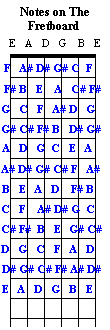FRETBOARD BASICS
Finding Notes on the Fretboard
One of the best ways of finding your way around the fretboard is to
become very familiar with all the notes on every fret on every string.
This will seem to be a very daunting task at first & should be tackled gradually.
The best method is to start with the notes in the first position (frets
1 to 4 including the open strings) then progressing to learn the notes
in the 5th position (frets 5 to 8) & then to learn the notes in the 9th
position (frets 9 to 12) this will take time, practice & patience !!!
It is probably more important at this stage to be able to easily work
out any note on the fretboard by following these next few instructions.
- Notes simply follow the same letters in the alphabet from A to
G (A B C D E F G). After reaching the note G we go back to the beginning letter A & cycle through the 7 alphabet letters again.
- After each alphabet letter, the next note will be its sharp (#).
e.g. after "F" the next fret note is F# after G the next fret note will
be G# etc. There are 2 exceptions to this rule !! after the note E the next
note is F (There is no E#) and after the note B the next note is C not B#.
(There are some keys and chords where these notes do exist, however to make life simple we will ignore them for this exercise.)
- The next step is to memorised the names of the 6 strings from
the 1st string (thinnest string) to the 6th string (thickest string) these
are from thickest to thinnest:
Avoid using memonics it is far simpler to just remember the string names.
- Using the steps so far we can easily work out all the notes say on
the G string (3rd string). Starting with the open string G the next note up
on the 1st fret will be G#, the 2nd fret note will be A, the 3rd fret note
will be A#, 4th fret B, 5th fret C (no B# remember), 6th fret C#, 7th fret
D, 8th fret D#, 9th fret E, 10th fret F (no E#), 11th fret F# & 12th
fret G again. This G note is one octave higher than the open string G.
- The other thing to keep in mind is that the sharp notes (#) can also be the flat (b) of the fret note above. e.g. F# can also be called Gb, G# can
also be the note Ab, A# can also be Bb, C# can also be Db, and D# can also
be Eb. It will depend on what Key you are in as to whether the note will be
a Sharp or Flat.Moving from the l2th fret on the first string E back down
the neck, the notes will be: Eb, D, Db, C, B, Bb, A, Ab, G, Gb, F and back
to the open string E. Notice there are no Fb or Cb notes.
- This same procedure can be applied starting on any of the open strings
& working up or down the fretboard.
- It is often useful to memorise some of the notes using the position markers on the neck. Learning all the notes at the 3rd & 5th fret positions is a definite step towards knowing your guitar fretboard.
- As well as increasing your knowledge of the fretboard,one of the
most important aspects of knowing your notes is to be able to locate the tonics of moveable chord shapes.

